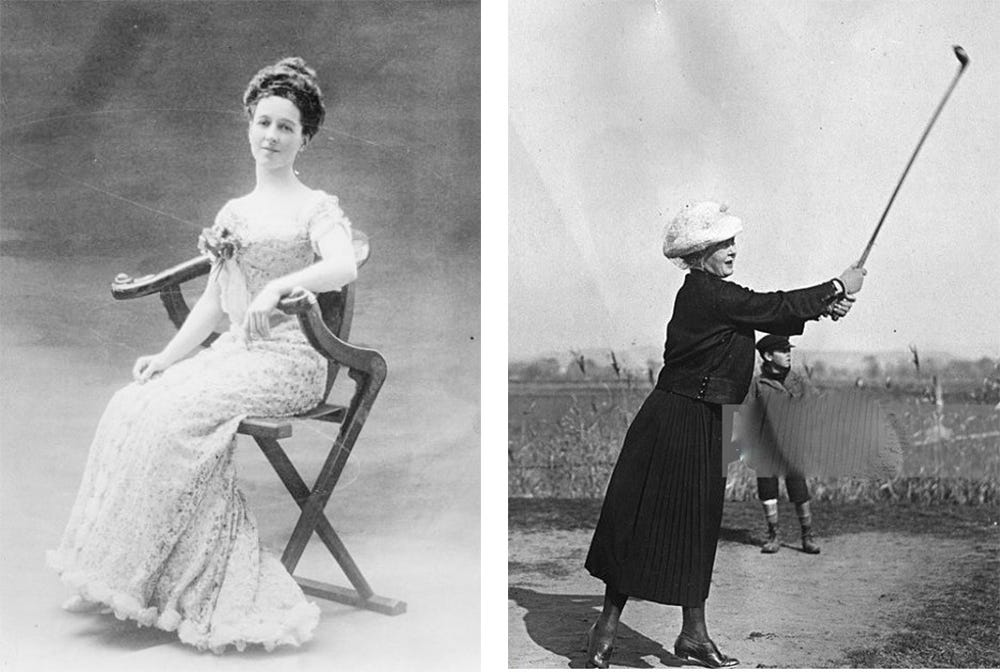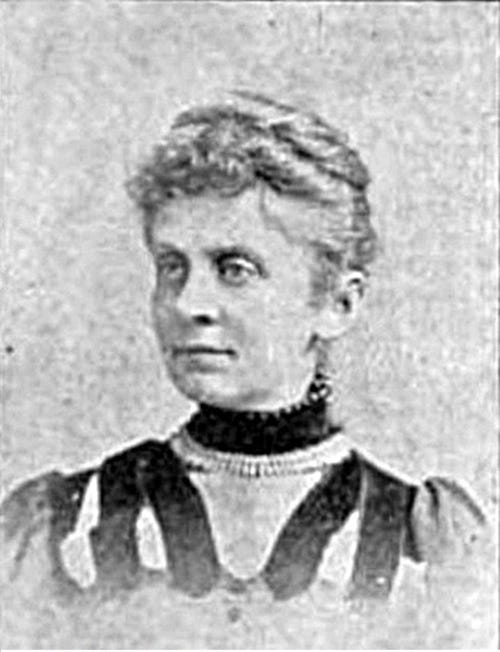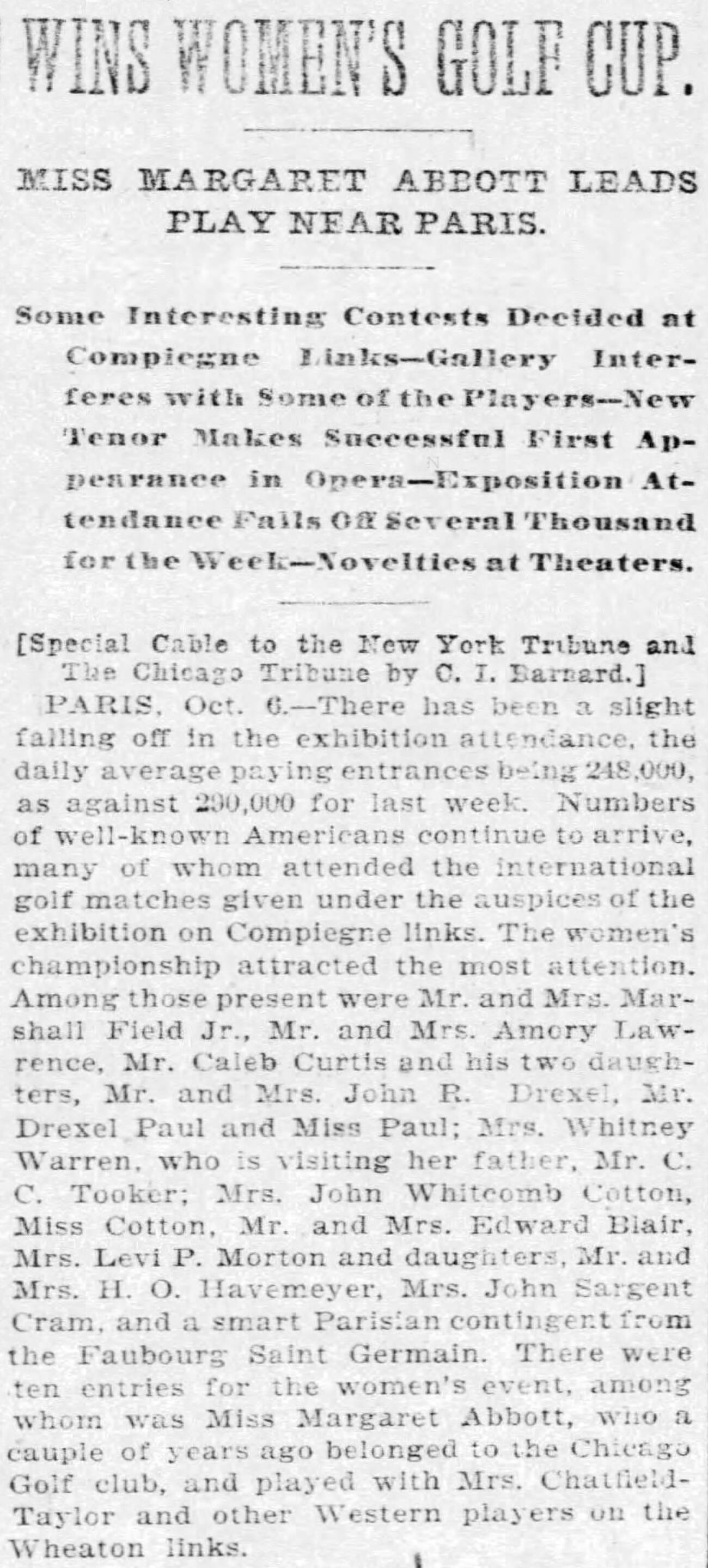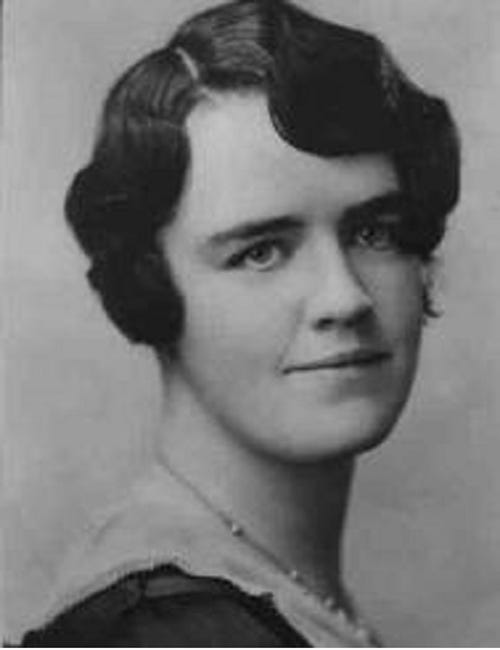Untold gold: America's first female medalist
Margaret Abbott won first Olympic golf event in Paris 1900, and died not knowing what she'd done
Margaret Abbott plays in the “ladies golf competition” at a course in Compiègne, France, during the Olympic Games in 1900. Photo was published in La Vie au Grand Air magazine on Oct. 14, 1900 and is held by the USGA Museum.
Odds are that you didn’t know that the first American woman to win an Olympic event was a golfer. That’s okay, the woman who won it never knew that either.
Margaret Abbott died in 1955 never knowing that she’d won the golf event in the 1900 Olympic Games near Paris, France. She didn’t even know she’d ever competed as an Olympian. All she got was a gilded porcelain bowl for winning a nine-hole tournament she and her mother entered — the “Prix de la ville de Compiègne” on October 3, 1900 — after seeing a notice about it in the newspaper while living abroad in Paris.
“There were 10 entries for the women’s event, among whom was Miss Margaret Abbott, who a cauple [sic] years ago belonged to the Chicago Golf club, and played with Mrs. Chatfield-Taylor and other Western players on the Wheaton links,” wrote the Chicago Tribune on Oct. 7, 1900.
Abbott just happened to be in the right place at the right time. In 1899, she and her mother moved to Paris, where the 22-year-old Margaret studied art in classes under the tutelage of the father of modern sculpture, Auguste Rodin, and French impressionist painter Edgar Degas.
Abbott had quite the pedigree herself, though not as an artist. She was born to American parents in Calcutta in 1878. Her father, Charles Abbott, worked as a merchant in India and her mother, Mary, was a descendent of the Pilgrims in Massachusetts. After her father died, her mother moved the family back to the United States and ended up in Chicago when Margaret was just 6 years old.
Chicago happened to be home to the oldest 18-hole golf course in America built by C.B. Macdonald — Chicago Golf Club. Mary Abbott was a member, and her son, Sprague, and daughter, Margaret, both took up the sport.
Margaret proved to be the most notable. She and C.B. Macdonald himself partnered in a tournament at Washington Park in 1897. The Chicago Tribune often took note of Margaret’s game. When she placed second and won an ebony putter during a competition at Chicago GC in 1897, the Tribune noted that the young woman “had an unfortunate time in bunkers, but played a plucky game.”
“Miss Abbott plays golf with exceptional grace and looks exceedingly well on the links,” The Inter Ocean reported on July 31, 1898. “Her drive is of considerable length, and on the green she is entirely at her ease. If she continues to advance as rapidly as she has heretofore it is predicted that Miss Abbott will ultimately take a place as one of the best women golfers in the United States.”
The Inter Ocean assessment proved somewhat prescient. Living in Paris in 1900 when the Olympic Games and the World Exposition took place simultaneously, Abbott saw the newspaper ad and signed up to play in the nine-hole tournament with her mother. Ten women — five from France and five more from the United States who all happened to be in Europe either studying or vacationing — participated in the event on Oct. 3, 1900, at a course located about 30 miles north of Paris.
Margaret Abbott shot 47 for the nine holes, which was two and six shots better than fellow Americans Pauline “Polly” Whittier (49) and Daria “Abbie” Pratt (53), who finished second and third.
1900 women’s golf medalists Pauline Whittier (silver) and Daria Pratt (bronze). (Olympedia)
“The reason American women excel is because they play with men. French women are just beginning to play men – their husbands and brothers. Even in England the golf clubs are mostly for men,” Abbott told the Buffalo Courier in its Oct. 8, 1900, edition.
She told her son, however, that she won "because all the French girls apparently misunderstood the nature of the game scheduled that day and turned up to play in high heels and tight skirts.”
Mary Abbott finished seventh in the 10-player field with a 65. They remain the only mother-daughter duo to compete in the same event in the Olympics, a fact neither one of them ever knew.
Mary Abbott joined Margaret as only mother-daughter Olympians in same event (Olympedia)
In fact, nobody really knew until the 1980s, when Paula Welch – a professor and the first women’s basketball coach at the University of Florida as well as member of the Olympic Board of Directors – published her doctoral dissertation on American women in the Olympic Games.
How could it take more than three-quarters of a century for anyone to know? It’s complicated.
While serving as a representative for the U.S. Olympic Committee and visiting the committee’s New York City headquarters in 1973, Welch came upon a plaque that had Abbott’s name misspelled on it. It caught her attention enough to launch a personal research project the learn more about the honored golfer.
Ten years later, Welch contacted Abbott’s family (she married with the findings of her research. “She never knew she was an Olympic champion,” Welch said before the 1996 Summer Olympics in Atlanta when Abbott was the featured athlete of the 1900 Games in the official Centennial Olympics program. “It was a piece of Olympic history that I felt people should know more about.”
Thanks to Welch’s notification, Philip Dunne, one of Abbott’s sons, published the story, “My mother, the golf Olympian,” in Golf Digest in 1984.
“It’s not every day that you learn that your mother was an Olympic champion, 80-odd years after the fact,” Dunne wrote. “The champion herself had told us only that she had won the golf championship of Paris — she won the golf championship of France at the resort town of Dinard a few weeks later — and mystified us by insisting that the championship of the city was the more important.”
Here's what caused all the confusion.
Frenchman Pierre de Coubertin revived the modern-era Olympics in 1986. Like the original ancient Games, it was a male-only affair — although the athletes were clothed this time unlike the ancient Greeks. Women weren’t even allowed to watch the first sanctioned Olympics, much less participate.
In 1900, however, women featured for the first time in a handful of socially acceptable non-contact sports — tennis, sailing, croquet, equestrianism and golf. A total of 22 women (out of 997 athletes) managed to either sneak or stumble their way into the competition.
It turns out that the 1900 Olympics in Paris weren’t as well-organized as the ones that delivered the meticulously choreographed Opening Ceremonies along the Seine this time around. The 1900 Games were held in coordination with World’s Fair — known as the Paris Exposition — and were spread out over six months and so poorly promoted “to an extent that many athletes never knew they had actually participated in the Olympic Games,” according to the International Olympic Committee.
Golf Illustrated referred to the women’s golf event as being “in connection with the Paris Exhibition,” and it was commonly billed as the “Exposition Competition” or “Paris World’s Fair Competition” instead of being referred to as an Olympic event.
It wasn’t until after the 1900 events concluded that the International Olympic Committee decided they would include some of the events as Olympic competition – tennis and golf. The women’s tennis event, which included six players from four nations on July 6-11, 1900, was won by Great Britain’s Charlotte Cooper, making her the first official female Olympic gold medalist. France’s Hélène Prévost was credited with the silver, while American Marion Jones Farquhar and Hedwiga Rosenbaumová of Bohemia are credited with sharing bronze.
Margaret Abbott (Olympedia)
Abbott is credited as the first female American gold medal winner, even though the Olympics didn’t start the tradition of awarding golf, silver and bronze medals until the 1904 Games in St. Louis, Mo. There was a men’s but no women’s golf event in the 1904 Games, and after that year golf would disappear from the Olympics for the next 112 years.
The whereabouts of Abbott’s Olympic trophy remains a mystery. It’s not at the USGA’s Golf Museum in New Jersey, where the silver trophy awarded to 1900 men’s Olympic golf champion Albert Lambert is displayed along with other mementos from the Olympic Games. No known photos exist either of Abbott’s trophy — described as an “old Saxon porcelain bowl mounted in chiseled gold.”
But Abbott’s achievement is now a known part of the historical record, and she and fellow American Nelly Korda share a connection as women’s Olympic golf gold medalists separated by a mere 121 years.







